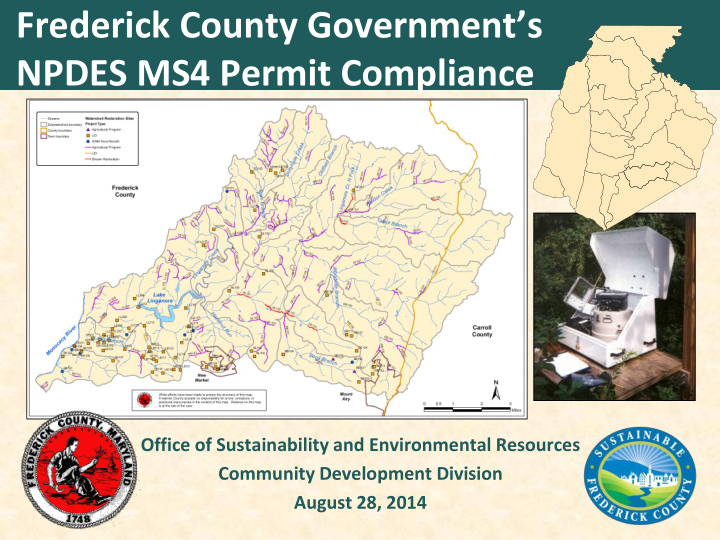



Frederick County Government’s NPDES MS4 Permit Compliance Office of Sustainability and Environmental Resources Community Development Division August 28, 2014
Overview • About Frederick County • Current Programs: Highlight on budget and restoration efforts • Comments on Tentative Determination 2
About Frederick County • Approximately 664 sq miles • 1,400 miles of streams through 5 state watersheds: Lower and Upper Monocacy Rivers, Catoctin Creek, Double Pipe Creek, Potomac River • Staff have subdivided watersheds into 20 NPDES management units with smaller branches and catchments • County is 35% forest, 58% agriculture, 5% urban • Most urban land is within municipalities, not MS4 3
About Frederick County • Home to urban non-municipal population estimated at 81,889 (Aug. 2014) • Distinct places ranging from small, rural communities to more developed areas • No ultra-urban areas 4
Current Program Requirements Current NPDES MS4 permit requirements: • Establish legal authority to control storm drain discharges; • Monitor and characterize urban runoff; • Map storm drain infrastructure, hydrology, sewers, etc; • Develop watershed management plans to identify pollutant sources; • Correct stormwater impairments, restore watersheds; • Treat 10% of untreated “impervious” area; • Identify and correct illicit discharges to the storm sewer system; • Conduct public education and outreach; • Comply with sediment and erosion control regulations; • Provide adequate funding 5
MS4 Permit Financing TBD Amount Collected through Fee Costs Per Year MS4 Permit Per Year Average through 2013 Budget for FY'14 Request for FY'15 Draft MS4 Permit with 20% Retrofit $5,349,890 $3,559,136 Costs Per Account $2,500,000 • $0.01 per account stormwater remediation fee $488 • FY’14 budget $3.56M equivalent to $72.96/acct • Estimate of cost of draft permit underway 6
Watershed Planning and Restoration Watershed Assessments • Permit requires Watershed Assessments – Completed for Ballenger, Lower Bush, Lower Linganore, Bennett Creeks, Upper Monocacy and Lower Monocacy River Watersheds (~60% of county). • County proposes management options in Stream Restoration/Stormwater Management Facility Retrofit Assessments – Conducted voluntarily for Ballenger, Lower Bush, Linganore, Bennett – Not required by permit but useful for project development 7
Watershed Planning and Restoration Watershed Assessments • 2/15/2012: EPA recognizes Frederick County and MDE as having one of the best watershed assessments in the nation • 4/25/2012: EPA Region III notes the excellence of County’s GIS program, robust illicit discharge sampling program, strong watershed assessment program, and public access to permitting and inspection data • 5/09/2013: MDE congratulates County for “continued endeavors and commitment to the implementation of the municipal stormwater program.” • Completion of restoration goal in permit • Maintenance of adequate budget 8
Watershed Planning and Restoration 10% Impervious Area Restoration Requirement Completed 713 acres of 672-acre goal: • 125 ac. CIP projects; • 129 ac. Watershed Alliance partner projects; • 55 ac. Street Sweeping (Highway Operations); • 413 ac. Community Restoration Projects 9
Watershed Planning and Restoration Ballenger Creek Stream Restoration CIP example Ballenger Creek Stream Restoration CIP example – Restored channel at Ballenger Creek Elementary School; – Multiple benefits provided through coordination with FCPS, DUSWM, Parks; • Stabilized banks, reduced sediment, removed debris jams; • Protected sewer line from stream; • Created area for Ballenger Creek trail on bank and saved Parks $415K from having to install pedestrian bridge; • Improved habitat for fish, birds, other organisms 10
Watershed Planning and Restoration Urbana High School SW Retrofit CIP example • Partnered with FCPS • Existing stormwater pond treated volume but not quality; • Constructed bioretention facilities in courtyard and bus lot to treat quality; Bioretention and pavers in courtyard • Facilities look like landscaping feature; • Provided porous pavers at emergency exits; school extremely pleased with this feature, which adds safety and protects grass UHS bus lot before and after 11
Watershed Planning and Restoration Linganore Stream Restoration CIP example Linganore CIP example: • Selected Pinecliff Park stream restoration • Degrading stream was source of sediment and nutrient pollution • Coordinated with Parks • Protects park assets, water line, road culvert from erosion Candidate sites for restoration in the Linganore Watershed based on Restoration/Retrofit Assessment. Map and detail. 12
Comments on Tentative Determination: MEP • Maximum Extent Practicable (MEP) is the legal compliance standard for MS4 permits • Some parts of Draft Permit exceed MEP level of effort – Due to cost, scheduling, other issues – Ex., 20% restoration requirement • Some are impossible regardless of funding and time – Ex., litter and floatables program “elimination” goal • The County is finalizing analysis of its MEP – Can only agree to accept a permit if it is practicable 13
Comments on Tentative Determination • County has met commitments under current MS4 program • County has more than doubled resources in anticipation of next permit • County wants to implement the Draft Permit to Maximum Extent Practicable 14
15
Recommend
More recommend